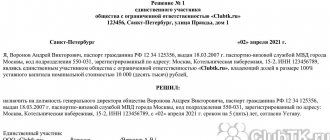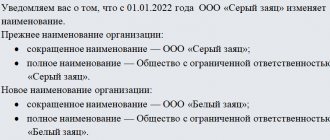Office management and document flow are concepts that many consider synonymous, but this is not so. Office work is everything that concerns working with documents, from their creation to transfer to the archive. This refers to ensuring that documents are created, transferred from department to department, and stored after completing their task.
Document flow means the movement of documents, i.e., in fact, this is the stage that lies between the creation of a document and its destruction or transfer to the archive. Office work and document flow in an enterprise are closely related, since the latter is part of the former.
Charter
The charter is a legal act that regulates the formation of an organization, its competence, main functions, working conditions and tasks. Essentially, it is a set of rules that governs the activities of any organization, society or citizens.
When a legal entity is formed, the charter must be approved by a group of its founders and must be registered in accordance with the law. It is the main document in the activities of organizations of absolutely any legal form of ownership and regulates their relationships with other organizations or individuals, and also establishes their responsibilities and rights within the scope of their activities. The charter refers to the mandatory internal documents of the organization.
The content of the charter must comply with the requirements of current legislation. The charter must include:
- name and type of enterprise;
- his postal address;
- purpose and direction of activity;
- the procedure for the formation of the authorized capital and distribution of profits;
- other aspects of activity.
Staffing and headcount
A document fixing the names of departments, available positions and the number of units in the staff is called the staffing level. Like the regulations, the staffing level is unified in the system of organizational and administrative documentation. It must also be issued on a general form. The staffing level has a visa from the chief accountant of the enterprise, the inspector of the personnel department, the direct manager and must be certified by a seal.
Other internal and external documents of the organization will be discussed below.
A document fixing the positions and number of employees at an enterprise, as well as the payroll, is called the staffing table. The document form has a unified name T-3 and is a table containing job titles, tariff rates, salaries, allowances and other information. The preparation and approval of the staffing table is the responsibility of the chief accountant of the enterprise.
What other internal documents of the organization exist?
Occupational safety documents: storage periods for logs, instructions and other occupational safety documents
Local regulations are subject to storage. The storage period is established by the Order of the Federal Archive of December 20, 2019 No. 236 “On approval of the list of standard management archival documents generated in the course of the activities of state bodies, local governments and organizations, indicating their storage periods.”
This order is mandatory for all employers, regardless of their organizational and legal forms and form of ownership. The nomenclature of occupational safety cases must be drawn up indicating in section 7.3 of the List of storage periods.
| Name of documents | Storage conditions |
| Reports on the special assessment of working conditions (SOUT), lists of workplaces, summary statements, declarations of conformity, SOUT maps for specific workplaces, lists of measures to improve working conditions and labor protection) | At the location - 45 years, but in the presence of harmful and dangerous working conditions - 50 years (documents completed after January 1, 2003) and 75 years (documents completed before January 1, 2003). In other organizations - 5 years (in the organization that conducted the SOUT) |
| Work permit for work with increased danger, log of work according to work orders and orders | Within 1 year after the closure of the permit, in the presence of industrial injuries, accidents and accidents at work - 45 years |
| Medical examination documentation | 5 years EPC, that is, after 5 years the commission will determine which documents need to be selected for permanent storage and which can be disposed of |
| Investigation and recording of occupational diseases | • 50 years - if the documents were completed after January 1, 2003 • 75 years - if the documents were completed before January 1, 2003 |
| Investigation and recording of accidents | 45 years |
| Documents confirming occupational safety training: - knowledge testing protocols - logs of occupational safety training (introductory and on-the-job) | 5 years 45 years |
| Lists (statements) for the issuance of personal protective equipment, flushing and neutralizing agents, milk and other equivalent food products, therapeutic and preventive nutrition | 1 year |
| Industrial sanitary control program | 5 years |
It should be noted that Rosarkhiv is not a federal executive body for labor protection, and therefore allows for outdated, unnecessary wording. For example, paragraph 408 of the order states that the organization must keep “Certificates of Compliance with Occupational Safety and Health (Safety Certificates)” . At the same time, certification of work on occupational safety is not regulated by the Labor Code of the Russian Federation and other legal acts, therefore, such certificates are not required to be maintained and stored. In this case, you can organize the storage of copies of certificates and declarations for flushing agents and workwear for 5 years.
These documents will be needed if you are going to reimburse the costs of preventive measures to the Social Insurance Fund, or if you receive a GIT inspection. Also, in personal cards for issuing PPE and flushing aids, you must indicate the numbers of certificates or declarations, so copies should always be kept at hand.
How to destroy occupational safety documents
After the storage period for documents expires, they can be disposed of. Disposal is carried out by order of the head of the organization. A specially created commission determines the value of documents. If there is no value, the period has expired, then the document is transferred for destruction on its own or with the involvement of a specialized organization.
Important! It is not allowed to throw away documents that may contain personal data as municipal solid waste.
It is allowed to use various document shredding technologies for destruction, including a shredder, and if we are talking about a digital document, the commission controls the erasure of information or formatting of the media.
Job Descriptions
These are regulations that define the rights and obligations of the organization’s employees, the scope of their activities, and the scope of responsibility. They occupy a special place in the structure of internal documents of the enterprise. It is on the basis of job descriptions that a contract with an employee is developed and concluded. Thus, it is the employment contract and staffing table that are used to resolve a conflict situation between the employee and the employer if it arises.
The development of a job description is the responsibility of the HR department inspector, then it is agreed with the legal department and certified by the manager. Any change that is significant must be made by order of the director. This is required by the organization's internal regulations.
Personnel documents
Despite the fact that personnel document flow is gradually moving into electronic format, the organization must keep confirmation of the hiring, transfer, dismissal of employees and the amounts paid to them. For now, these data are the main basis for forming the insurance period when calculating a pension.
Therefore, the organization must ensure the storage of the following documents:
- Work books of employees, if they are kept in paper form, as well as books of accounting of forms, the books themselves and inserts for them.
- Employment contracts with each employee and additional agreements to them, if any.
- Local regulations, such as regulations on wages, bonuses, work and rest hours, and internal regulations. If the employer belongs to a micro-enterprise (less than 15 people, and annual income below 120 million rubles), then he can conclude a standard employment contract with employees, the form of which is approved by Government Decree No. 858 of August 27, 2016. The standard contract has already been included in regulations and are not required to be formalized separately.
- Regulations on the protection of personal data of employees.
- Personal cards of employees in the T-2 form.
- Staffing table in form T-3.
- Vacation schedules in form T-7.
- Timesheets for recording working hours and calculating wages (forms T-12 and T-13).
- Orders, personnel instructions and reasons for them, for example, a memorandum.
- All documents related to the calculation of salaries and other payments to employees.
- Documents on labor protection, as well as on certification or assessment of working conditions of workplaces.
- Job descriptions for each position, if the employment contract does not describe the employee’s functions.
- An agreement on full financial responsibility, if the employee’s position requires this.
- Journals and books of personnel records (employment contracts, orders, personal files, travel certificates, military records, etc.).
Acts
These are internal documents reflecting certain events or facts and compiled by several persons.
These documents are drawn up in various situations, therefore they have a huge number of varieties: these are acceptance acts, write-off acts, commercial acts. Must be compiled by a permanent commission or a commission appointed by the head. They are drawn up on the general form of the enterprise (if they are internal), must have information about the organization (if they are external).
The acts consist of two parts. In the first, they contain information about the subject and basis of the drafting, and the members of the commission. The second contains direct information about the work carried out by the commission and its results.
Signed by all members of the commission. If the act carries any material or financial burden, it must be approved by the manager and certified with a seal.
If the act affects the activities of other structural units or officials, then the latter must be familiar with it. Internal regulatory documents of an organization are often requested by inspection authorities.
Acts concerning important issues in the activities of the organization (reorganization, inspection, audit) must be stored on an ongoing basis. Less important ones must be stored for five years.
Requirements for the preparation of internal documents of an organization
Many internal corporate documents have legal significance, so a strict procedure for their execution is necessary. Companies create standard forms for certain types of documents that contain mandatory elements. Some documents have formatting requirements established by law or other regulation. As a rule, the mandatory components of the preparation of internal documents are:
- details - code, name and other information about the organization;
- dating - the date of its signing, approval, acceptance, registration;
- addressing—indication of the recipient's address. It can be an enterprise, a structural unit, an official;
- resolution on the document - includes the name of the executor in the dative case, the contents of the order, the deadline for execution;
- the text of the document and its title - contains all the information for which it was compiled.
Drawing up documents and recording their turnover takes a lot of time for each department of the organization. To optimize work processes, companies resort to document automation. It allows managers to see and control the overall picture of what is happening in all departments. And employees can interact smoothly between departments, increasing productivity. Programs for systematizing documents, preparing bank payments, and registering contracts greatly facilitate work processes. In addition, they allow you to organize remote work for employees with online access to all necessary files. The transition of many companies in Russia to a digital format is associated with the desire to get rid of paper accumulations, and the transfer of some documents to digital format is associated with new government requirements. For example, from January 1, 2022, it became possible to create electronic work books; a number of financial and accounting documents must be created and submitted to reporting authorities in electronic format. At the end of 2022, the Presidium of the Government Commission on Digital Development, the use of information technologies to improve the quality of life and business conditions approved the Concept of electronic document management in business activities and an action plan for its implementation. You can learn more about government plans for document digitization at the Doczilla and Terralink webinar here: You can completely automate office work with an electronic document management system (EDMS). It ensures work with electronic documents throughout their entire life cycle. The functions of the EDMS include the ability to create, correct, store and transfer documents over the network between devices, classification, etc. The system automates interactions between employees such as transferring documents, issuing tasks, sending notifications, etc.
Protocols
Record the progress of meetings and conferences, issues discussed at them and decisions made. The order of organization of internal documents must be observed.
As a rule, the minutes of meetings and sessions are kept by the secretary by taking notes or stenography. Includes the main points of the speakers and draft decisions on the issues raised. It is drawn up on the general letterhead of the enterprise indicating the name of the event being recorded, the date of its holding, a list of participants and a serial number.
The protocol consists of an introductory part (the chairman, secretary and officials present, as well as the agenda are indicated) and a main part (includes sections corresponding to the agenda, descriptions of speeches and a resolution - decision).
The list of internal documents of the organization also includes acts on damage to property, shortages, damage or violations during transportation. These must be drawn up on company letterhead without any corrections or erasures.
Reports, official, explanatory notes
Office and memos are documents that are addressed to the head of an enterprise or any department (in rare cases, to a higher authority). Contain information on any issue related to the activities of the enterprise or officials, proposals or conclusions.
A memo is an element of internal correspondence. Drawed up if the issue between departments cannot be resolved orally. If necessary, get approval from the manager. It can be compiled either in handwritten or printed form.
The memo must have a title and body text that reveals the essence of the event that gave rise to its preparation, as well as conclusions and proposals. The date is the date of composition. It must be signed by the originator, and if sent to higher authorities, also by the head of the organization.
Internal notes relating to the activities of the enterprise and sent to higher authorities are stored permanently, and internal control documents of the organization are stored for five years.
Explanatory notes are drawn up in any form and contain information on labor relations. As a rule, they contain information about the reasons that led to any violations. Depending on the importance, they are stored from one year to five years.
Inquiries
These are internal documents that describe and confirm facts and events. The most frequently used certificates at an enterprise are certificates of wages and confirming the fact that an employee works at this enterprise. At his request, the organization is obliged to issue him such a certificate.
Often, an enterprise uses formalized certificate forms to speed up the process of their preparation and subsequent issuance.
The certificate must contain information about the employee to whom it is provided, his position and salary. It must have the date of compilation, signatures of managers, and the seal of the enterprise.
A separate type of certificates are certificates on production topics, which can be provided upon request from management. These are drawn up in two copies: one is provided to the addressee, the second is attached to the case.
Accounting for internal documents of an organization must be strict.
Organizational administrative documents
The following types of administrative documents are distinguished:
- Order. Published by the management of the organization in order to solve production problems. There are orders on production issues and orders on personnel. The first include orders regarding financing, supply, sale of goods or services, and distribution of resources. The second - about hiring or dismissal, about vacation or business trip of an employee. Must be signed by the manager and brought to the attention of those persons whose activities it affects.
- Decisions and orders. Acts issued for the purpose of promptly resolving issues that arise during production. They are predominantly methodological and informational in nature. Decisions and instructions are drawn up identically to orders and are issued in one of the following cases: if it is necessary to distribute responsibilities or determine the deadlines for completing a particular task; when determining the procedure for using vehicles, and so on. Orders, as a rule, consist of an administrative part and a stating part, and have a separate clause designating a supervisory body in the form of a unit or official. Signed by the director, numbered within the boundaries of the calendar year. If they relate to the main activities of the enterprise, they are stored permanently; for economic and administrative matters - for five years.
Organizational documents: taking into account the new standard
What document details and design rules should you pay special attention to when using GOST R 7.0.97-2016, first of all?
These are the important points:
- Fonts. To create a document, the font size is limited; you can only use 12, 13, 14 numbers. Smaller font is allowed, but only in tables.
- Coat of arms. Documents can now display the coat of arms of a constituent entity of the Russian Federation or a municipal entity (10 mm from the top of the sheet).
- Requisites. Company details such as OKPO, OGRN, INN, KPP are indicated as part of the “reference information about the organization” detail.
- A note about restricting access to document information. It is placed on the first sheet, on top, in the corner.
- Addressing the addressee. Now you can use the address “Mr.” and “Mrs.,” abbreviating it: “Mr.,” “Ms.” If the recipient has an email and the letter was sent through this channel, you can specify the email address to which the letter was sent.
- Seal of the organization. It should not “overlap” the official’s signature on the document.
- Signature. A citizen who has the right to sign documents for a temporarily absent manager cannot put a slash sign in front of the manager’s position on the printed form or use the preposition “for.” The correction may be made by hand or a certain type of stamp may be placed indicating that another person is signing the document.
Conclusion
Requirements for the preparation of documents in office work are currently established by the state standard, in force since the middle of last year under No. R 7.0.97-2016. Based on GOST, organizations and institutions develop their own standards for the preparation of documentation. Standardization of document flow is necessary because it makes it possible to quickly process, search and copy documents. Compliance with the requirements for the preparation of documents allows us to speak of them as legally significant.
In the current GOST, the legislator offers recommendations on the preparation of details, forms, and sets out the requirements for creating documents. Compared to the defunct standard, some controversial and unclear issues are given special attention. In particular, it explains in what font the document should be created, how a signature for the director of another responsible person is drawn up, and it states that the seal of the organization should not be placed over the signature of the responsible persons.






